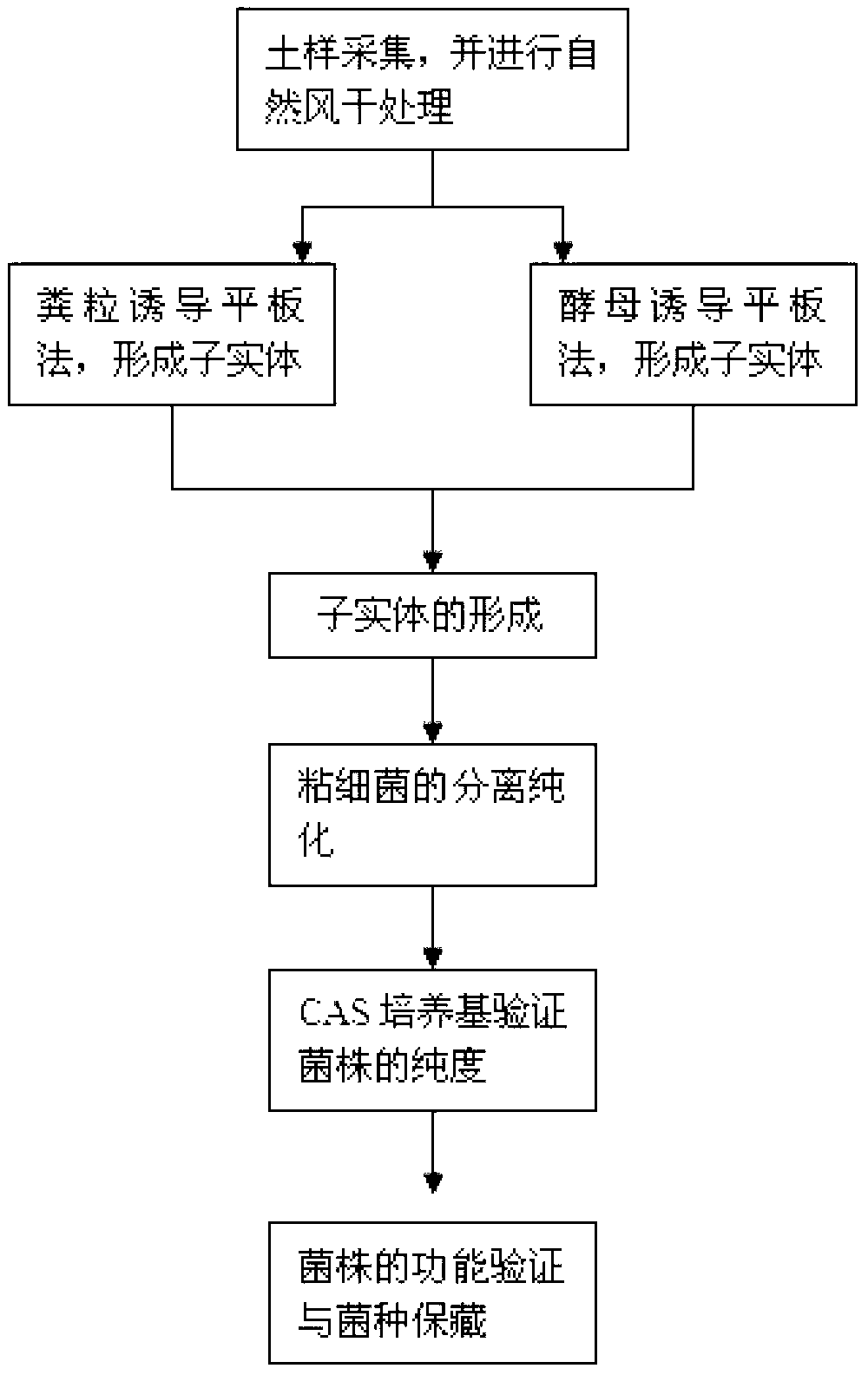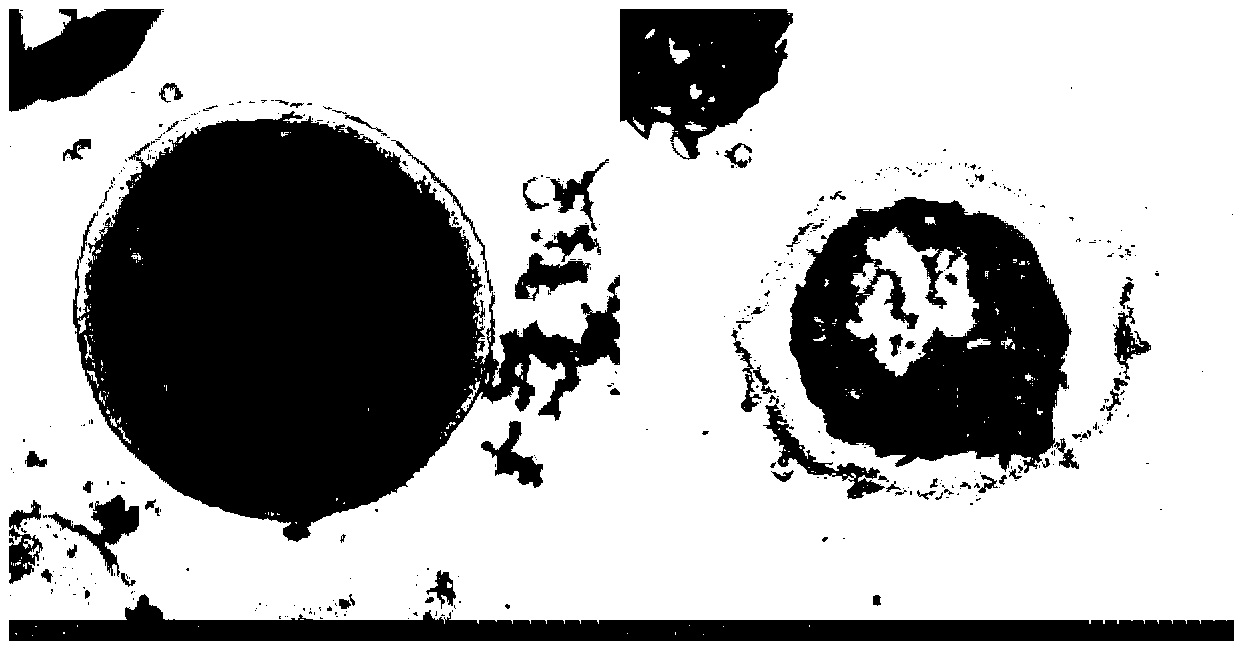Corallococcus coralloides and application thereof
A kind of coralline coccus and drug technology, applied in the field of applied microbiology, can solve the problems of few model strains, difficult screening and cultivation, etc.
- Summary
- Abstract
- Description
- Claims
- Application Information
AI Technical Summary
Problems solved by technology
Method used
Image
Examples
Embodiment 1
[0034] Embodiment 1. Isolation and purification of bacterial strains
[0035] 1.1 After the sample is collected, let it dry naturally at room temperature (to reduce the pollution of mold and miscellaneous bacteria).
[0036] Soil samples were collected from Dongying, Shandong and air-dried naturally at room temperature.
[0037] 1.2 Induction of myxobacteria fruiting bodies
[0038] 1.2.1 Fecal particle induction plate method: Put about 20 grams of air-dried soil samples in a petri dish, half bury 3-4 sterilized rabbit feces on the surface of the soil samples, add 25 μg / mL ether sterilized put After soaking for 6 hours with cycloheximide (25mg / ml) or carbendazim (30mg / L), pour off the residual liquid, incubate at 30°C, and observe the formation of fruiting bodies on the feces ball after 48 hours.
[0039] 1.2.2 Yeast induction plate method: use WCX (penicillin penicillin final concentration 100mg / L) medium as the base medium, pour it into a sterile plate, draw a cross line w...
Embodiment 2
[0052] Embodiment 2. Identification of strains
[0053] 2.1 Morphological features ( image 3 )
[0054] The isolated and screened myxobacteria EGB were negative by Gram staining, and the morphology of the strain was observed under a 100× oil lens through crystal violet staining. It was found that the strain was rod-shaped, without flagella, and transparent at both ends , under the transmission electron microscope, there is a layer of mucus around the single bacteria; through the light microscope 10× observation, it is found that the strain has a colony effect during the growth process, and the single bacteria gather together to form fruiting bodies in the late growth period.
[0055] 2.2 Identification
[0056] Through the PCR amplification of the 16S rDNA of the strain, the 16S rDNA gene sequence of the strain was obtained, logged in NCBI (www.ncbi.nlm.nih.govPblastP), and the obtained sequencing results were compared with the known sequences in the database using BLAST s...
Embodiment 3
[0057] Embodiment 3. Study on Resistance of Corallococcus sp. EGB to Several Phytopathogenic Fungi
[0058] 3.1 Select a suitable medium (angie yeast 0.5%, CaCl 2 2H 2 O0.1%, potato 30%, glucose 2%, agar 1.5%) make strain EGB (CCTCC NO: M2012528) and several plant pathogenic fungi: cotton fusarium wilt, cucumber yellow wilt and rice smut grow without interfering with each other. First pick several kinds of plant pathogenic fungal hyphae to the center of the plate, after the pathogenic fungus grows strong hyphae, connect the isolated myxobacteria EGB (CCTCC NO: M2012528) on both sides, and culture at 30°C for 4-7 days , it was found that the surrounding mycelia of several selected plant pathogenic bacteria withered gradually, and their growth was obviously inhibited ( Figure 5 ).
[0059] 3.2 Inoculate the strain EGB (CCTCC NO: M2012528) into VY / 4 liquid medium (Angelica 0.5%, CaCl 2 2H 2 O0.1%pH7.0), cultured at 30°C for 3-4 days, centrifuged at 6000rpm for 20min, coll...
PUM
 Login to View More
Login to View More Abstract
Description
Claims
Application Information
 Login to View More
Login to View More - R&D
- Intellectual Property
- Life Sciences
- Materials
- Tech Scout
- Unparalleled Data Quality
- Higher Quality Content
- 60% Fewer Hallucinations
Browse by: Latest US Patents, China's latest patents, Technical Efficacy Thesaurus, Application Domain, Technology Topic, Popular Technical Reports.
© 2025 PatSnap. All rights reserved.Legal|Privacy policy|Modern Slavery Act Transparency Statement|Sitemap|About US| Contact US: help@patsnap.com



